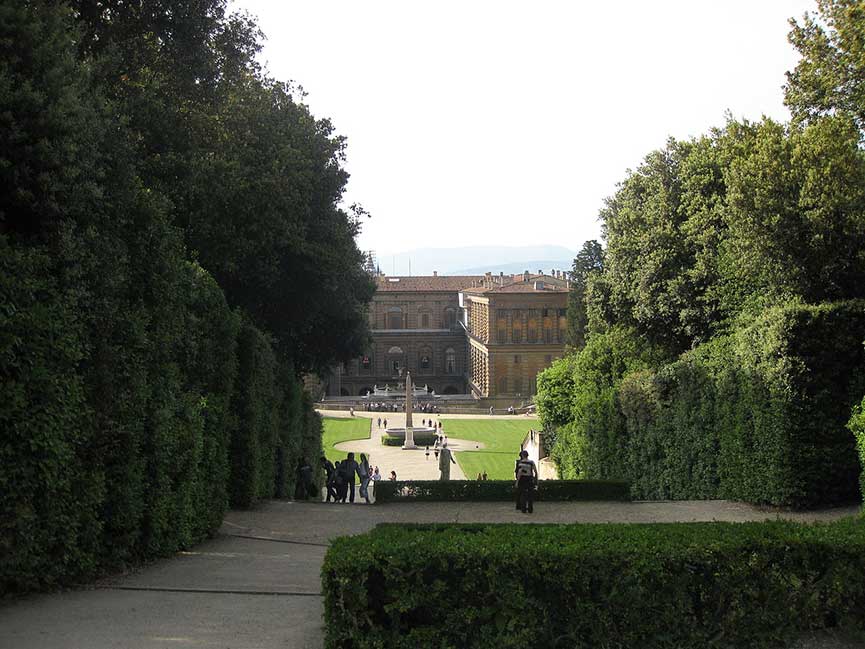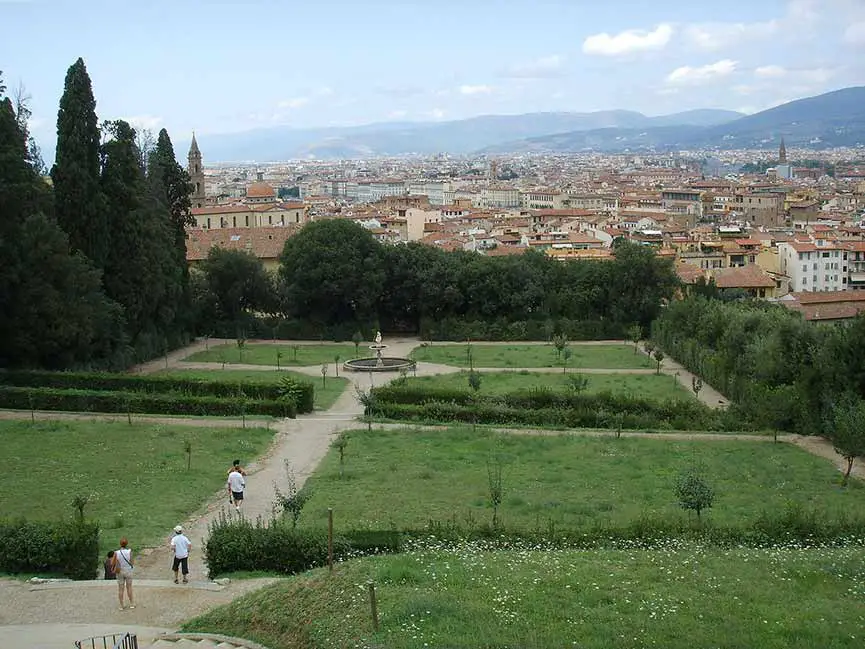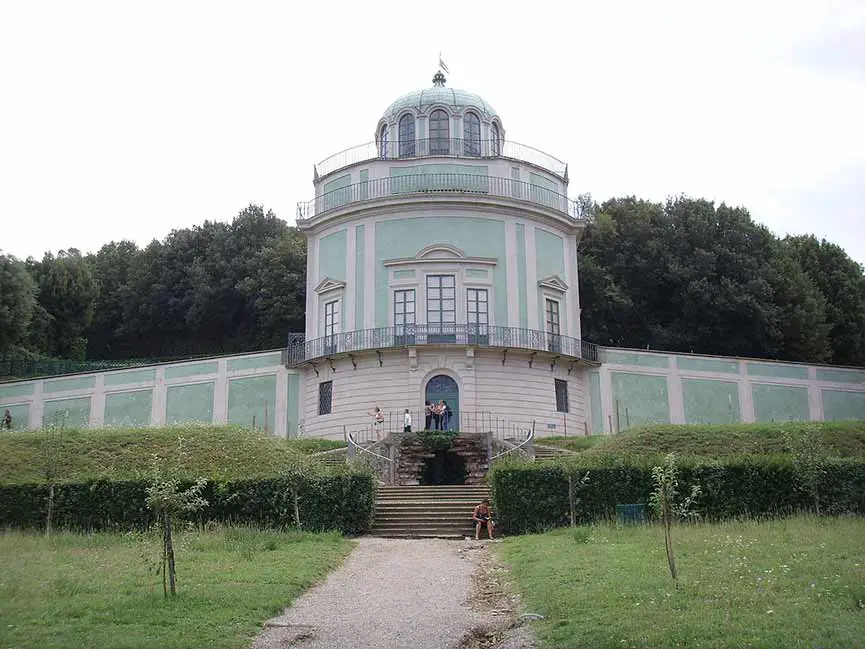 Boboli Gardens - Palazzo Pitti - Florence Boboli Gardens - Palazzo Pitti - Florence
(Photo: Deror avi, CC BY-SA 3.0, via Wikimedia Commons)
The Boboli Gardens is a state museum that is part of the museum pole of the Uffizi Galleries which also includes Palazzo Pitti, the Vasari Corridor, the Uffizi Gallery.
The Garden is located behind Palazzo Pitti, the historic residence of the Medici starting in 1550, then passing to the Habsburg-Lorraine dynasty starting in 1737 and finally to the Savoy who lived here until 1919. The Garden is a real open-air museum and welcomes almost 1 million visitors every year as it is one of the most famous gardens in Italy.
Tickets and Guided Tours including the Boboli Gardens of Florence

Tickets available: Boboli Gardens skip-the-line ticket, guided tour of the Garden, private tour of the Garden + Palazzo Pitti
Boboli Gardens in Florence
The Boboli Gardens is one of the most famous and visited gardens in Italy with 1 million visitors and is a recognized UNESCO World Heritage Site.
The Garden occupies an area of 45,000 m² which houses an architecture and a sculptural apparatus that made it, right from its opening, a perfect example of an Italian garden which was then imitated in many European courts.
The Boboli Gardens, hosting various sculptures from the Roman era, copies of classical and Hellenistic Greek statues, but also Renaissance and seventeenth-century statues, turns out to be an open-air museum (it is in fact included in the list of museums of the Uffizi Galleries) unique in the world.
Inside there are also various exotic tree species and different architectural emergencies commissioned by the Medici and Hapsburg-Lorraine dynasties who governed Florence from the Renaissance onwards.
Access to the Boboli Garden Museum is possible from 4 different points: from Palazzo Pitti, from Forte Belvedere, from Via Romana and from Porta Romana. |

History of the Boboli Gardens in Florence
The history of the Boboli Gardens is linked to the Medici family, bankers who rose to power in the 13th century and ruled Florence for centuries.
(Foto: I, Sailko, CC BY-SA 3.0, via Wikimedia Commons)
In 1549 Eleonora di Toledo bought Palazzo Pitti, the historic Renaissance residence of the banker Luca Pitti who had it built - to a design by Filippo Brunelleschi - starting in 1458 at the base of the Boboli hill in the Oltrarno.
At the time of purchase, the building had only three doors and a double order of windows; Bartolomeo Ammannati was then called - who was working on the project for the Fountain of Neptune in Piazza della Signoria - to expand it and transform it into one of the most famous noble palace models in Europe. The construction of Palazzo Pitti and the Boboli Gardens were started at the same time. For the Boboli Gardens, Niccolò Pericoli (1500 - 1550), known as Tribolo, was called in and designed the layout, dividing it into sectors where he planted rare trees and wild plants and arranged the hedges. But Tribolo died prematurely and Ammannati himself took charge of the garden, who designed the Grotta di Madama, built from 1553 to 1555, with the aim of recreating naturalistic environments populated by sculptures depicting mysterious beings and animals.
Meanwhile, the construction of Palazzo Pitti continued as normal with the pietraforte that was quarried in the Garden itself, transforming an area behind the central courtyard into an amphitheater, designed by Tribolo who designed it adorned only with vegetation. Following the death of Vasari (1574), Bernardo Buontalenti, a former pupil of Tribolo and Ammannati, was appointed court architect of the Medici, who designed the large grotto of Boboli, known as the Buontalenti Grotto, a masterpiece of Italian Mannerist art.
Starting from 1599, the steps were added to the Amphitheater while the statues had to wait for the arrival of Giulio Parigi in 1631, who completely transformed the original green architecture project. Finally, in the first half of the 18th century, the Egyptian obelisk originally from Luxor and already erected in the Temple of Isis at Campo Marzio, and the large basin from the Baths of Caracalla in Rome arrived.
Upstream the whole complex was dominated by the Statue of Abundance, begun by Giambologna in 1608 and finished by Pietro Tacca in 1636. It actually depicts Joan of Austria, wife of Francesco I de' Medici, who died in Palazzo Pitti at the age of only 32 for a accident.
To get there you climbed a side of Boboli which in 1777 was arranged with a double flight of stairs on which three Roman statues were placed: a Septimius Severus on the left, a Roman Magistrate on the right and a Demeter in the centre. At the end of the ramps, the Basin of Neptune was opened due to the presence of a statue depicting the god by the sculptor Stoldo Lorenzi (1571) called by the Florentines with evident mockery Fountain of the fork.

(Foto: I, Sailko, CC BY-SA 3.0, via Wikimedia Commons)
Going further, you reached the highest point of Boboli where Cosimo III had the Casino del Cavaliere built in 1700, then completed at the end of the century with the Giardino del Cavaliere, the work of Zanobi del Rosso. Literary symposiums were held here and Gian Gastone, son of Cosimo III, established his very personal retreat there. Finally, the Lorraines used it as a venue for their summer court parties.
Meanwhile, in the seventeenth century, Giulio Parigi was succeeded by his son Alfonso Parigi the Younger, with whom the gardens extended southwards along a main route which took the name of Viottolone. Roman and eighteenth-century statues were placed at the crossroads with the three secondary avenues, while the Vasca dell'Isola was designed and built on the southern side, with a work by Gianbologna, the Ocean Fountain, in the center.
In the mid-eighteenth century other architects carried out transformations: among them again Zanobi del Rosso. to which the Grand Duke Pietro Leopoldo commissioned the design of two architectural complexes that completed the current form of the Garden: the Kaffeehaus and the Limonaia.

(Foto: I, Sailko, CC BY-SA 3.0, via Wikimedia Commons)
The Kaffeehaus, built in rococo style in 1776 and culminating in a terrace covered by a glazed dome from which you can enjoy a panoramic view, immediately became one of the main destinations for the Lorraine walks.
The Limonaia was built two years later to protect the court's lemon production. The Medicis were among the first to appreciate the ornamental characteristics of lemons which, however, had to be protected from the cold in winter. From this need arose the new building that took the place of the previous Animals Menagerie, a place assigned to receive exotic animals purchased or received as gifts from the embassies of other European courts (in the catalogue, in full Baroque style, there were also giraffes and a hippopotamus).
Informazioni utili per la visita al Giardino di Boboli
Orari: da lunedì a domenica apre alle 8.15. Chiusura: alle 16.30 in gennaio, febbraio, novembre, dicembre. Alle 17.30 in marzo e ottobre (con ora solare). Alle 18.30 in marzo (con ora legale), aprile, maggio, settembre, ottobre (con ora legale). Alle 19.00 in giugno, luglio e agosto.
Chiuso il primo e ultimo lunedì del mese, eccetto che tra giugno e ottobre; 1 gennaio; 25 dicembre.
Biglietti: intero € 10. ridotto € 2. Prenotazione ingresso € 3. Passepartout 5 Giorni: ingresso singolo valido per 5 giorni per Uffizi, Palazzo Pitti, Giardino di Boboli € 38.
|
